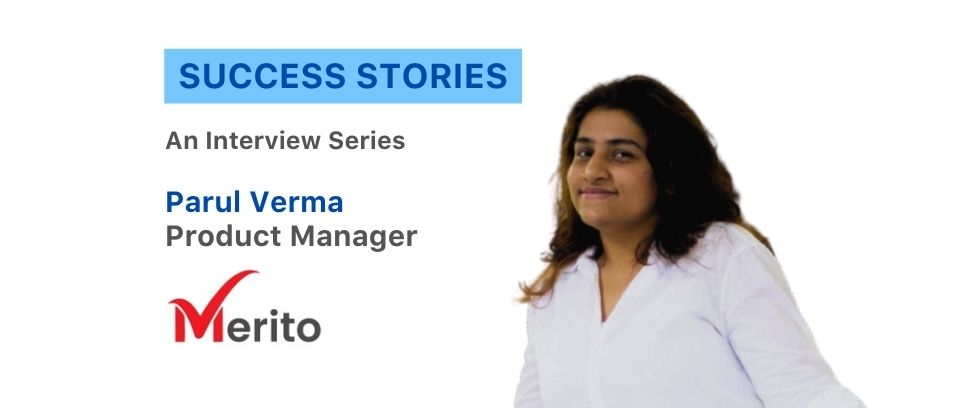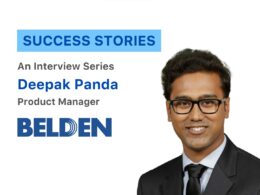In our newest Success Stories blog post, we feature Parul Verma, who is a Product Manager at Merito. Join us as she narrates her journey, from initially working as a Product Strategist, then joining Executive Program in Product Management and Data Science to steering products as a product manager.
Discover more about Parul’s career transition and the impactful strategies she employs in shaping product offerings.
Q1. Tell us about your current role and background.
I recently joined a company called Merito as a Product Manager, and it’s been just two weeks. Many of my roles and responsibilities are still being defined. However, I will be working on creating an enrollment suite for the education industry, where Merito is one of the top leaders.
To give some background about myself, I have a BTech degree and an MBA. My career journey began in coding, then transitioned into marketing. I realized that while coding, I missed interacting with people, and in marketing, I missed the technical aspects. What attracted me to product management is that it offers the best of both worlds. As a Product Manager, I get to be involved in technology while also engaging with stakeholders, customers, and various teams like development and design. This blend of technical and interpersonal interaction is what drew me to product management.
Q2. What challenges did you face while exploring a Product Management role?
I transitioned into product management four years ago after working as a pure marketer in an ed-tech startup. My role primarily involved defining retail codes and managing marketing tasks. Knowing I wanted to move into product management, I joined Leena AI as a Product Manager. However, my role initially focused on growth product management, which involves driving user adoption and retention.
At Leena AI, I helped set up processes but felt my responsibilities leaned more towards marketing than product management. I discussed this with inbound product managers and co-founders, and eventually transitioned from Growth PM to Inbound PM.
A major challenge I faced was that my CV was heavily marketing-oriented, despite starting my career as a developer. This made it difficult to showcase my technical skills. Another challenge was that transitioning roles is often easier within the same company. At Leena AI, I leveraged my rapport with stakeholders to facilitate my switch from Growth PM to Inbound PM.
Additionally, I realized the importance of structured learning. My CV didn’t reflect my product management skills, so I had to learn many concepts on the job. I encountered terms like “prioritizing sprints” and “story points” that were unfamiliar. To bridge this gap, I sought out a product management learning course to better understand industry terminology and practices, ensuring I could excel in my role.
Q3. How has Product Management helped you in your new role?
TI agree that taking a structured course has been incredibly helpful. My CV didn’t initially reflect my product management skills, so I had to learn many things on the job. This included understanding various technical terms and concepts like “prioritization sprints” and “story points.”
While I grasped what needed to be done, I lacked familiarity with the specific terminology used by development and product teams. This gap made me feel less effective in my role, prompting me to seek out a product management course to bridge my knowledge and enhance my capabilities.
Q4. What was the interview experience at your current company?
I progressed through two rounds of interviews. They went like:
Round 1:
- Introduction: Basic questions about my background.
- Case Study: Focused on a current user problem the organization wanted to solve. They were more interested in my approach than finding a perfect solution.
Round 2:
- Introduction: Again, introducing myself. Having a strong personal story sets the tone for the interview.
- On-the-Spot User Problem: I was given a user problem and asked to create a basic product idea and a go-to-market strategy.
- Guesstimates: I was asked to estimate the daily number of views the company might be getting overall.
Q5. Why Accredian? How did it help you?
I’m someone who loves learning and frequently takes courses. I knew I wanted a live, instructor-led course rather than just watching videos, so I was clear on the type of pedagogy I preferred. While I was already gaining product management knowledge from other sources, I also wanted to deepen my understanding of data, especially since I work in AI and data is crucial for a Product Manager.
Accredian was the only course that offered both product management and data science. I’m not looking to become a data scientist, but I wanted to understand the behind-the-scenes of data science to enhance my product management skills.
Q6. What advice would you give to Product Management beginners?
To get started in Product Management, begin by reading the basics or taking a course to build your CV. However, just completing a course isn’t enough. If you’re a beginner, focus on building your portfolio with case studies, assignments, and product tear-downs.
Engage in market research, identify problems, and ideate solutions. Get hands-on with tools like Figma for creating prototypes, and explore no-code/low-code tools. Familiarize yourself with Jira and other PM tools, but don’t get too fixated on them. The key is to be curious about problems and passionate about user journeys. Mastering this mindset is crucial for a PM, and everything else will enhance your ability to apply it in your business framework.
We hope you found this success story interesting. If you have any Product Management questions, please fill this form and we will get back to you.






